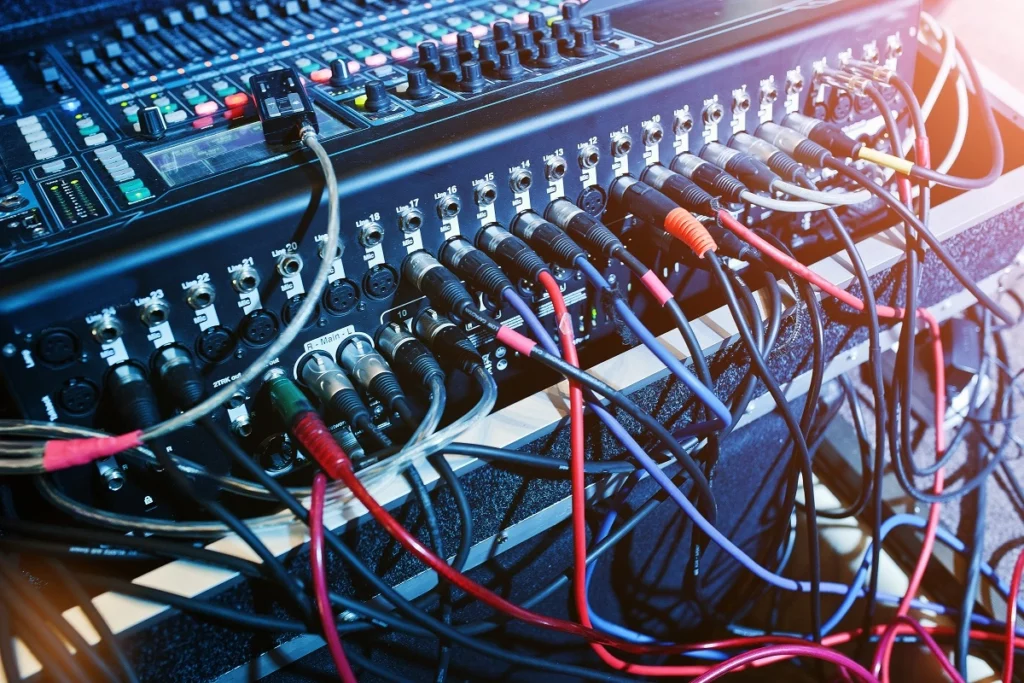The Ultimate Guide To Connect Ceiling Speakers To Receiver!
Are you prepared to transform your living area into a haven of sound? Connect ceiling speakers to receiver is a method for immersing yourself in an immersive audio experience. In this guide, we will take you through the process of linking your ceiling speakers to the receiver.
No need to worry if you’re not an audiovisual technician – we have you covered with simple steps and helpful tips. So, let’s embark on this journey together and create a home environment where every note, conversation, and sound effect is delivered with accuracy and clarity.
Simplify Ceiling Speaker Connections with XTEN-AV’s Smart Design Tools
The all-in-one solution for your AV needs
Transform your audio-visual experience with XTEN-AV.
No Credit Card required
Key Takeaways
- Discover how to seamlessly connect ceiling speakers to a receiver.
- Learn essential steps, tools, and pre-installation considerations for optimal setup.
- Gain insights on wiring, calibration, and speaker placement for an immersive audio experience.
AV Design Mastery + Winning Proposals = 10x Productivity!
- Automatic Cable Labeling & Styling
- 100+ Free Proposal Templates
- Upload & Create Floor Plans
- 1.5M Products from 5200 Brands
- AI-powered ‘Search Sense'
- Legally Binding Digital Signatures
No Credit Card Required
Steps to Connect Ceiling Speakers To Receiver
Here’s what you are looking for: this is a step-by-step guide to help you connect your ceiling speaker to the AV receiver.
Prepare the Work Area:
First, you must ensure that the power is shut down and all electrical appliances are unplugged. This will help you proceed with a safe working setup and give you a stable working area. Remember, whenever electricity is involved, safety should be your priority.
Prepare Speaker Wires:
It’s time to prepare the speaker wires to be connected to the AV receiver.
Take a high-quality speaker wire, measure it, and cut it at the required length. Connect the speaker cables to each ceiling speaker placement from the receiver. You can use conduits, cable channels, or other hiding techniques for a tidy installation. Secure these wires along the walls with cable staples.
Connect Speaker Wires to the Receiver:
Find out the positive and negative terminals to the corresponding terminals on the receiver, then strip a small portion of the wire. Then, connect the speaker wires to the receiver by binding them, or if you have banana plugs, you can also use them. Again, ensure that power is off while you do this, and everything is unplugged.
Mount Ceiling Speakers:
Your speakers are now connected to the AV receiver. There are two more steps to go, and you’re ready to enjoy your home theater. In this step you have to mount the ceiling speakers back.
If you are doing it again, you probably already know how to do it, but if it’s your first time, check out our guide on How to wire ceiling speakers.
Power On and Test:
Power on the receiver and connected audio sources, set it to the appropriate mode (stereo, surround sound), and perform a sound test to ensure ceiling speakers function correctly. If the receiver has room calibration features, run the calibration process.
A Detailed Checklist of Tools And Materials Required
Tools | Materials |
Wire Cutter | High-Quality Speaker Wire |
Crimping Tool or Banana Plug Connectors | Ceiling Speaker Mounts or Brackets |
Screwdriver Set | Drywall Anchors and Screws |
Stud Finder | Wall Plates and Connectors |
Drill and Drill Bits | Mounting Template |
Fish Tape or Wire Pulling Tool | Manuals and Documentation |
Measuring Tape | Grommets or Bushings (optional) |
Cable Staples or Clips | Decorator Plates (optional) |
Ladder | Cable Channels or Conduit (optional) |
Tips For Connecting Ceiling Speakers To Receiver Seamlessly
Sometimes little hacks can save us a lot of time and energy. Well, these tips are going to work like a magic wand while you try to connect your receiver and speaker. Do ensure you try applying as many tips as possible.
1. Use High-Quality Speaker Wire:
High-quality speaker wires are always essential because first, they will last longer, and second you can easily contact the companies if any inconvenience is caused. You will also have to ensure that you choose the right gauge according to the distance between the receiver and ceiling speakers.
2. Label Speaker Wires:
This tip is a lifesaver if you’re connecting multiple speakers. You should label the speaker wires at both ends to avoid any kind of confusion at the time of installation and in the future. This way, you won’t have to bang your heads figuring out which wires to connect; a clear solution will be available in front of you.
3. Check Polarity:
Make sure you properly connect the positive and negative terminals of the speaker wires to both the receiver and the ceiling speakers. It’s important to maintain the polarity for sound reproduction.
4. Calibrate Your System:
Most receivers are equipped with built-in tools for calibration or setup. Take advantage of these features to adjust the levels of your speakers, distances, and other settings according to the acoustics of your room. Calibration guarantees a balanced audio experience across all speakers.
5. Secure and Conceal Wiring:
Install the speaker wires in an organized manner, either by running them through walls or using cable channels. This will not only enhance the appearance but also minimize the potential for damage or any tripping hazards caused by exposed wires.
6. Verify Receiver Settings:
Review the settings on your receiver and ensure that it properly detects the ceiling speakers. Certain receivers might need adjustments for channel setups. Consult the receiver’s manual for instructions on how to configure and adjust the speaker settings.
7. Test Before Final Installation:
Before you permanently install the ceiling speakers, make sure to connect them and do an audio test. This way, you can resolve any issues before finishing the installation.
Pre-Installation Considerations Before Connecting Ceiling Speakers to Your AV Receiver
Well before you start this journey you definitely have to be prepared with various things. Why worry when we are here to do the research for you. Follow the below guidance and you’ll be prepared to connect your speaker and audiovisual receiver.
Speaker Impedance Matching:
Ensure that the impedance of your ceiling speakers, which is measured in ohms, aligns with the impedance rating mentioned by your receiver. If the impedance doesn’t match it can lead to power transfer. Even cause harm to your audiovisual equipment.
Power Handling Capacity:
Check the power capacity of both the ceiling speakers and the receiver. It’s important not to exceed the power handling capability of the speakers, with the receivers power output. Overpowering them can cause distortion. Potentially damage the speakers.
Wiring and Cable Gauge:
Use the gauge of speaker wire based on the distance between your receiver and the ceiling speakers. It’s generally advised to go for wire which has a gauge number, when dealing with longer distances. This helps minimize any loss of signal. Additionally ensure that you establish a secure connection, between the wires, the receiver and the speakers.
Room Acoustics and Placement:
Take into account the room’s acoustics. Carefully consider where to position the ceiling speakers. The placement of the speakers can have an effect on both the quality of sound and its coverage. Furthermore, it’s worth checking if your receiver has any room calibration or equalization capabilities that can help enhance performance by adapting to the characteristics of the room.
Amplification and Receiver Channels:
Consider the acoustics of the room when deciding where to position the ceiling speakers. The placement of these speakers can impact both the quality and its coverage. Additionally, it is worthwhile to check if your receiver has any features, for room calibration or equalization that can optimize performance by adjusting to the characteristics of the room.
AV Design Mastery + Winning Proposals = 10x Productivity!
- Automatic Cable Labeling & Styling
- 100+ Free Proposal Templates
- Upload & Create Floor Plans
- 1.5M Products from 5200 Brands
- AI-powered ‘Search Sense'
- Legally Binding Digital Signatures
No Credit Card Required
Conclusion
Well done! You’ve managed to connect ceiling speakers to receiver unlocking a new level of audio pleasure.
Following our instructions and suggestions you’ve not only established connections between devices but also integrated a harmonious symphony into the very essence of your home.
Now sit back and enjoy the amazing experience you’ve created for yourself.
Frequently Asked Questions:
Certainly, a receiver is crucial when it comes to ceiling speakers as it helps boost signals giving power to the speakers. It acts as the hub, for connecting audio sources guaranteeing optimum performance and control over the sound system.
Installing fire hoods on ceiling speakers prior to connecting them to a receiver will not have any effect on the quality. Fire hoods are primarily intended to ensure fire safety by offering a barrier in case of a fire emergency while still allowing the connection and functionality of the speakers and receiver to remain unaffected.
Moisture levels, in places such as kitchens will not have an impact on the connection of the receiver. However, it is important to select speakers that are resistant to moisture in environments in order to avoid any potential damage. Make sure there is ventilation, and consider using a receiver that has features when in humid settings.
Bluetooth ceiling speakers come with their amplifiers. Can easily connect to Bluetooth-enabled devices. Although you don’t necessarily need a receiver you have the option to use one if you want features. These speakers provide a solution for audio streaming without relying on a traditional receiver.



